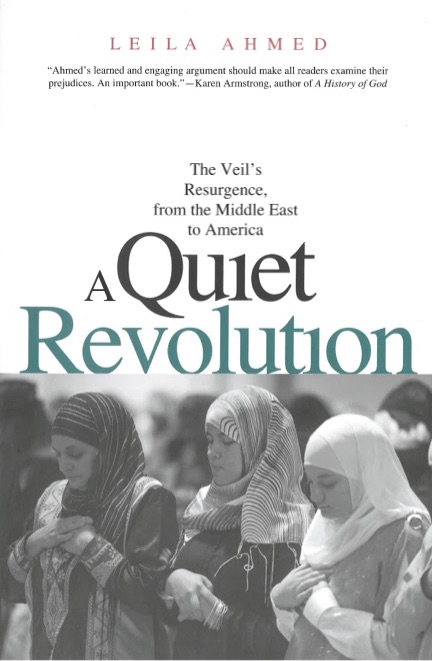The Islamic Hijab & Veil

By Charles Ponnuthurai Sarvan –March 26, 2017
A Quiet Revolution (Yale University Press, 2011) is by Leila Ahmed, an Egyptian-American; Professor of Divinity at Harvard University. Unless otherwise made explicit, what follows is from this study. The work’s focus is mainly from the 20th century onwards, with much of the reference being related to Egypt (to a lesser degree to Saudi Arabia) and the USA. The hijab and veil are emblems of Islam (p. 132) though, of course, there are pious Muslim women who don’t wear the hijab. Equally, to be a Muslim is not necessarily to be an Islamist: ‘Islamism’ is a very political form of Islam (ibid).
Women’s rights have been used as a cloak to attack Islam and the Muslim world in general; to denigrate and dominate (pp. 223-4). For example, the British Occupation of Egypt began in 1882, and Lord Cromer was appointed consul-general, a post he held for twenty-four years. Cromer who repeatedly decried the position of women in Islam was a fierce opponent of women’s rights in England. Indeed, he was for a time president of the ‘Society Opposed to Women’s Suffrage’ (p. 31). The presence of the veil was taken to be an indicator of the level of the backwardness of a society (p. 20) – isn’t it still? The Oxford historian Albert Hourani in The Vanishing Veil (1956) predicted that it would soon be a thing of the past (p. 19) but the veil reappeared in the 1970s (p. 8), and today we live in a world where veiling steadily gains ground across the globe (p. 305).
 The Caliphate which had existed under the Ottoman Empire was abolished in 1924 by Kemal Ataturk. In 1928, the Muslim Brotherhood was founded by Hasan al-Banna whose ideal was to work for humanity, particularly for the poor and oppressed. Their clinics, health-care centers and hospitals were open also to the needy who didn’t belong to the Brotherhood (p. 51). A Muslim Sisterhood was established in 1937 (p. 136). The Brotherhood was dissolved in 1948 and al-Banna murdered. Fleeing persecution in Egypt, members of the Brotherhood found refuge in Saudi Arabia which from the 1950s saw a massive increase in its oil-based wealth. The Kingdom, established in 1932, followed the teaching of Abd al-Wahhab (1709-92), and sought to Wahhabize Islam (p. 97). Members of the Brotherhood offered their experience and expertise, and it is they who ran Saudi projects, including publications and missions. (In the past, wealthy Egyptians had taken to wearing European-style dress. Now women returning from Saudi Arabia with money to buy houses, property or businesses imitated the Saudi dress-code: Saudi chic, p. 101. Besides, wearing the hijab a woman could leave the home, go out to work and yet signal that she was a good wife and mother: p. 122. This is particularly relevant in the context of over-crowding in buses, trains and offices.) A university was set up in Medina in 1961 to train Muslim missionaries (p. 61). The word jahiliyya (jahl = ignorance) referred to the pre-Islamic era in Arabia but Egyptian Sayyid Qutb (leading intellectual of the Brotherhood, hanged in 1966) asserted that most so-called Muslim countries were in fact not Islamic but rather were jahiliyya societies (p. 69). To Qutb, the Islamic confession of faith, “La illaha illa Allah”, was revolutionary: sovereignty lay not in governments but in Islam (p. 71), and the true path was through dedicated and selfless labour and struggle. Of the four types of jihad (jahada = to strive): the first and the greatest is the struggle with oneself. I am reminded of one of the sayings attributed to the Buddha, very much in line with Stoic philosophy: Greater than conquering others is the winning of control over oneself.
The Caliphate which had existed under the Ottoman Empire was abolished in 1924 by Kemal Ataturk. In 1928, the Muslim Brotherhood was founded by Hasan al-Banna whose ideal was to work for humanity, particularly for the poor and oppressed. Their clinics, health-care centers and hospitals were open also to the needy who didn’t belong to the Brotherhood (p. 51). A Muslim Sisterhood was established in 1937 (p. 136). The Brotherhood was dissolved in 1948 and al-Banna murdered. Fleeing persecution in Egypt, members of the Brotherhood found refuge in Saudi Arabia which from the 1950s saw a massive increase in its oil-based wealth. The Kingdom, established in 1932, followed the teaching of Abd al-Wahhab (1709-92), and sought to Wahhabize Islam (p. 97). Members of the Brotherhood offered their experience and expertise, and it is they who ran Saudi projects, including publications and missions. (In the past, wealthy Egyptians had taken to wearing European-style dress. Now women returning from Saudi Arabia with money to buy houses, property or businesses imitated the Saudi dress-code: Saudi chic, p. 101. Besides, wearing the hijab a woman could leave the home, go out to work and yet signal that she was a good wife and mother: p. 122. This is particularly relevant in the context of over-crowding in buses, trains and offices.) A university was set up in Medina in 1961 to train Muslim missionaries (p. 61). The word jahiliyya (jahl = ignorance) referred to the pre-Islamic era in Arabia but Egyptian Sayyid Qutb (leading intellectual of the Brotherhood, hanged in 1966) asserted that most so-called Muslim countries were in fact not Islamic but rather were jahiliyya societies (p. 69). To Qutb, the Islamic confession of faith, “La illaha illa Allah”, was revolutionary: sovereignty lay not in governments but in Islam (p. 71), and the true path was through dedicated and selfless labour and struggle. Of the four types of jihad (jahada = to strive): the first and the greatest is the struggle with oneself. I am reminded of one of the sayings attributed to the Buddha, very much in line with Stoic philosophy: Greater than conquering others is the winning of control over oneself.
The 1956 constitution gave Egyptian women the vote. “By 1962 women had been appointed to senior government positions, and all the women holding such positions were bareheaded” (p. 64). But more than the defeat by Israel in 1948, the defeat of 1967 had “an earthquake-like effect on the Arab world” (pp. 65-6): I suppose because it was not an honourable defeat but a humiliating debacle. Arab efforts at Westernisation hadn’t brought results, and the people now believed that salvation lay not in nationalism, not in socialism, but in Islam: an attitude encouraged by the ruling elite of Saudi Arabia and other Gulf kingdoms threatened by notions of socialism. The wearing of the hijab is influenced by non-religious factors and developments as well.
African Americans make up a considerable percentage of US Muslims (p. 11). Similarly, some of the so-called ‘Untouchable’ caste in India, rejecting a religion which sanctioned their rejection, converted to Buddhism. And Arundhati Roy in her novel, The God of Small Things, suggests with ironic humour that if there are “untouchables”, then there must also be “touchables”. Following the Soviet invasion of Afghanistan in 1979, America became an “Islamist haven” (p. 177) with the Reagan administration elevating Wahhabism to the status of ‘liberation theology’. Abdel Rahman, known as the blind sheikh, obtained his green card quickly, and Ayman al-Zawahiri was also in the US (p. 180).

